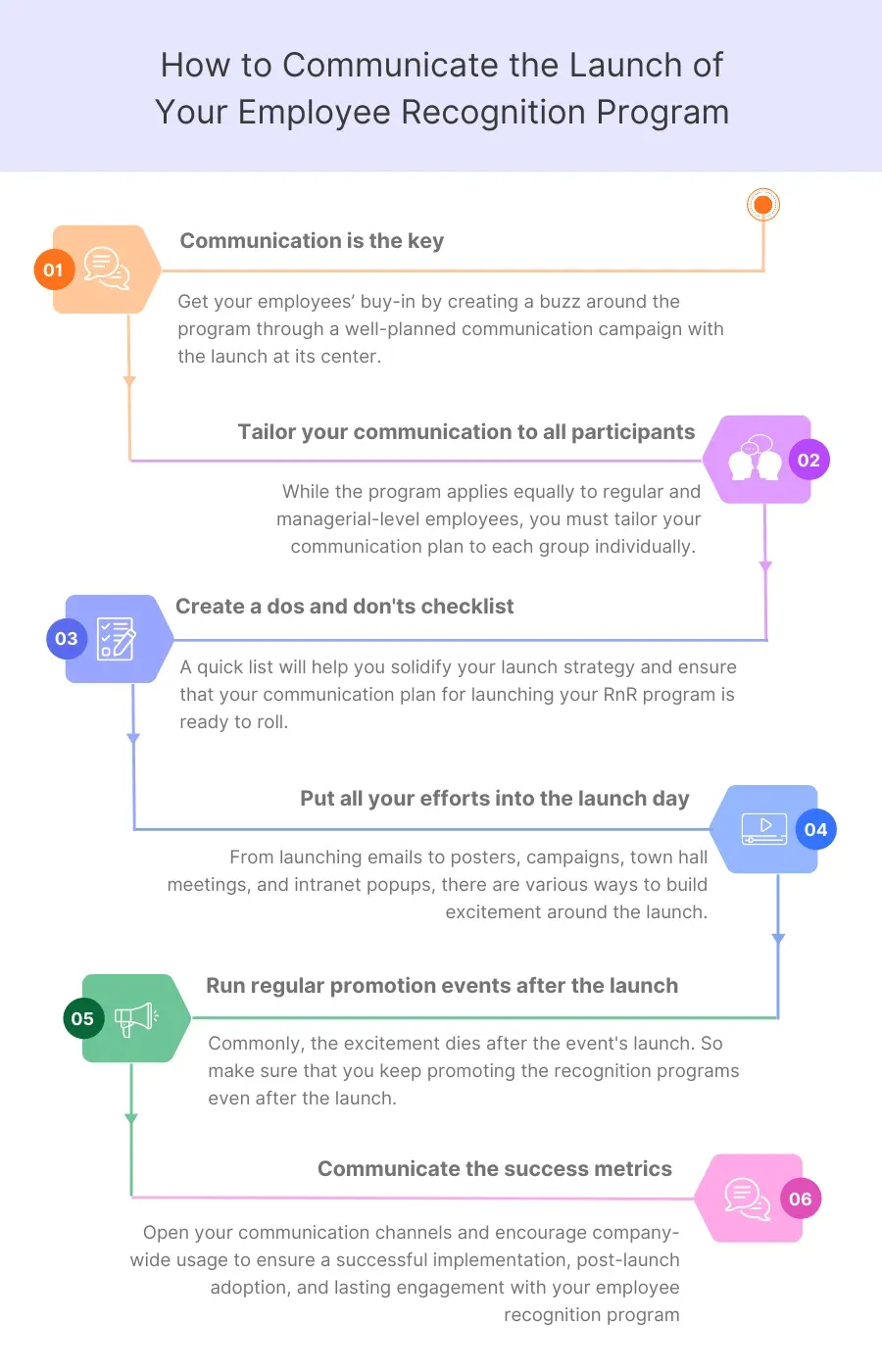Sukses Mengkomunikasikan Peluncuran Program Penghargaan Karyawan Anda

Jika Anda pernah merencanakan kegiatan Jumat yang menyenangkan dengan makanan ringan dan permainan hanya untuk melihat segelintir karyawan yang hadir, Anda telah mengalami sendiri mengapa memiliki rencana komunikasi penghargaan karyawan itu penting!
Sama halnya dengan program penghargaan dan pengakuan Anda. Jangan membawa kapal ke pantai hanya untuk melihatnya kandas di bebatuan! Berbulan-bulan menyusun strategi, anggaran, dan menyiapkan alat yang sempurna akan sia-sia jika karyawan tidak tahu apa-apa karena komunikasi yang buruk.
"Satu-satunya masalah terbesar dalam komunikasi adalah ilusi bahwa komunikasi telah terjadi." - George Bernard Shaw
Untuk melihat hasil maksimal dari investasi program Anda (melalui adopsi dan keterlibatan yang luas), rencana komunikasi yang terstruktur adalah kuncinya. Setiap karyawan harus melakukannya:
✔ Ketahui tentang program ini - Apa itu program ini, bagaimana cara kerjanya, dan mengapa program ini penting.
✔ Bersemangatlah untuk berpartisipasi - Pesan yang jelas yang mendorong antusiasme dan keterlibatan.
✔ Pahami imbalannya - Transparansi mengenai penghargaan, metode pengakuan, dan manfaatnya.
Rencana komunikasi penghargaan karyawan memastikan bahwa upaya Anda tidak luput dari perhatian. Blog ini akan memandu Anda melalui strategi yang telah terbukti tentang cara mengomunikasikan program penghargaan dan pengakuan secara efektif, memastikan karyawan tidak hanya menerimanya, namun juga secara aktif terlibat dengannya.

Komunikasi adalah kunci keberhasilan
Untuk mendorong budaya yang kaya akan pengakuan dalam organisasi Anda dan meningkatkan produktivitas secara keseluruhan, Anda telah menciptakan program pengakuan yang komprehensif yang memotivasi karyawan Anda di setiap langkah perjalanan mereka bersama perusahaan.
Namun, tidak cukup hanya dengan berinvestasi dalam program ini jika karyawan Anda bingung tentang tujuan dan manfaatnya.
Untuk menyukseskan program penghargaan karyawan Anda, Anda perlu melakukannya:
- Jelaskan tujuan dan proses program.
- Komunikasikan jadwal peluncuran dan soroti tim yang mengelola program.
- Tentukan perilaku yang memenuhi syarat untuk mendapatkan pengakuan dan manfaatnya bagi karyawan.
Dapatkan dukungan dari karyawan Anda dengan menciptakan gebrakan di sekitar program melalui kampanye komunikasi yang terencana dengan peluncuran sebagai pusatnya.
Mengapa
- Untuk menciptakan kesadaran tentang program dan perannya dalam menumbuhkan budaya apresiasi.
- Untuk mendapatkan dukungan dari karyawan dengan menciptakan gebrakan pra-peluncuran seputar program ini.
- Untuk mendorong adopsi program secara luas setelah peluncuran sehingga kontribusi semua orang diakui.
Bagaimana
- Sisihkan anggaran untuk kampanye komunikasi dan dapatkan dukungan dari C-Suite.
- Rencanakan acara perusahaan di sekitar peluncuran dengan komunikasi pra-peluncuran.
- Bangun momentum dengan email, poster, pemberitahuan, dan bahkan dari mulut ke mulut.
Kapan
- 1-2 bulan sebelum peluncuran yang sebenarnya; terlalu dini, dan kegembiraan akan hilang, terlalu terlambat, dan tidak akan ada momentum yang cukup.
- Lanjutkan setelah peluncuran yang sebenarnya untuk menjaga kegembiraan dan memaksimalkan ROI.
Menyesuaikan komunikasi Anda dengan semua jenis peserta
Meskipun program ini berlaku sama untuk karyawan biasa dan karyawan tingkat manajer, rencana komunikasi Anda harus disesuaikan dengan masing-masing kelompok.
1. 1. Untuk Karyawan
Sebagai kelompok sasaran untuk program penghargaan, upaya komunikasi Anda harus berkonsentrasi pada tujuan dan sasaran di balik program tersebut, rincian prosesnya, alat bantu yang akan digunakan, serta manfaat jangka pendek dan jangka panjang program tersebut bagi karyawan.
Jika memungkinkan, pilihlah beberapa pemain kunci untuk memperjuangkan program ini. Sebarkan informasi ini kepada karyawan Anda melalui rapat, materi orientasi, intranet, posting sosial, catatan di papan pengumuman, email, dan lainnya.
2. Untuk Manajer
Sebagai pemangku kepentingan penting dalam program pengakuan, para manajer dan supervisor harus mengetahui alasan di balik program ini. Sebagai pihak yang bertanggung jawab untuk memulai program pengakuan dan menjawab pertanyaan dari tim mereka, mereka harus memahami proses, teknologi, dan cara kerja alat/platform.
Pertemuan pemangku kepentingan, sesi pelatihan, paket tanya jawab, dan email akan membantu para eksekutif tingkat menengah untuk memahami dan membantu mereka membiasakan diri dengan program ini.
Metode untuk mempromosikan dan meluncurkan program penghargaan karyawan Anda
Dari email peluncuran hingga poster, kampanye, pertemuan balai kota, popup intranet, ada beberapa cara yang dapat Anda gunakan untuk membangun kegembiraan di sekitar peluncuran.
HR harus memulai komunikasi pertama beberapa minggu sebelum peluncuran yang sebenarnya; hal ini memberikan waktu bagi karyawan untuk memahami program, nilainya, imbalan yang ditawarkan, dan bagaimana program ini akan meningkatkan pengembangan karier mereka secara keseluruhan.
- 📰 S iaran pers: Awali komunikasi dengan strategi siaran pers yang kuat yang memperkenalkan program, menguraikan tujuannya, dan menyiapkan panggung untuk peluncuran.
- 📧 E mail: Satu email pengumuman saja tidak cukup! Kampanye email drip dengan penggoda pra-peluncuran, pengumuman peluncuran, dan tindak lanjut pasca-peluncuran akan memaksimalkan dampak program.
- 📢 Pemasaran digital dan cetak: Ciptakan kehebohan tentang program penghargaan karyawan Anda. Siapkan papan nama digital dan standee di sekitar lokasi kantor, mulai dari area resepsionis hingga kafetaria, papan pengumuman, atau tempat mana pun di mana Anda bisa mendapatkan perhatian maksimal untuk menyebarkan kesadaran. Pada saat yang sama, promosi digital melalui screensaver, pemberitahuan pop-up, dan ticker bergulir akan membuat program ini selalu ada di benak mereka.
- 🗣 Intranet dan media sosial internal: Intranet perusahaan berfungsi seperti media sosial internal untuk mendiskusikan peluncuran, memberikan informasi, dan mengintip pra-peluncuran kepada karyawan. Gunakan jajak pendapat dan kuis untuk mengundang saran, mendiskusikan umpan balik, dan gambar spanduk untuk mempopulerkan peluncuran.
- 👨💻 Townhall/Kegiatan: Bangun kepercayaan dan kredibilitas dengan meminta para pemimpin bisnis dan sumber daya manusia perusahaan menyoroti aspek-aspek penting dari program dan implementasinya selama pertemuan balai kota di seluruh perusahaan (di lokasi atau virtual). Ajaklah berdiskusi dan bertanya untuk melibatkan karyawan, rencanakan kegiatan yang menyenangkan, dan kirimkan hadiah kecil untuk menciptakan kehebohan.
R&R Kehidupan Nyata Diluncurkan dengan Faktor 'Wow'
Perusahaan-perusahaan ini telah membuat nama untuk diri mereka sendiri bukan hanya karena program pengakuan mereka tetapi juga karena cara mereka meluncurkan program R&R dan kemeriahan di sekitarnya.
➡ Heineken mengemas ulang dan meluncurkan kembali program R&R-nya dengan semua lonceng dan peluit. Menjelang peluncurannya, program ini mencakup komunikasi omnichannel melalui email, postingan media sosial harian, stand dan poster, SMS kepada karyawan, screensaver PC, dan banyak lagi.
➡ Cox Communications merencanakan festival peluncuran selama seminggu dengan aktivitas lengkap seputar platform Spark R&R. Mereka mengubahnya menjadi acara tahunan yang dimulai dengan email bertema yang menyenangkan di seluruh perusahaan yang mengumumkan perayaan Spark Week.
"Cara untuk memberi tahu karyawan "siapa" yang menerima penghargaan dan "mengapa" tergantung pada budaya organisasi. - SHRM
Daftar Periksa untuk perencanaan SDM dalam meluncurkan R&R mereka
Daftar periksa singkat akan membantu Anda memantapkan strategi peluncuran dan memastikan bahwa rencana komunikasi Anda untuk meluncurkan program penghargaan dan pengakuan karyawan Anda sudah siap.
Yang harus dilakukan ✅
- Siapkan strategi komunikasi pra-peluncuran dan dapatkan dukungan dan anggaran dari manajemen yang lebih tinggi.
- Buat rencana kampanye yang tangkas, lacak hasil menggunakan alat perencanaan proyek dan tunjuk pemimpin kampanye untuk memastikan eksekusi yang tepat.
- Tentukan apa yang ingin Anda fokuskan - program R&R itu sendiri atau alasan pelaksanaan dan peluncurannya.
- Sampaikan pesan dengan benar dengan menguji kampanye pada kelompok kecil dan sesuaikan berdasarkan umpan balik.
- Pastikan komunikasi Anda - poster, email, grafik, nada konten, dan gaya selaras dengan merek perusahaan.
- Lakukan segala cara pada hari peluncuran untuk meningkatkan kegembiraan dan mendapatkan dukungan karyawan.
- Soroti proposisi nilai bisnis dan manfaatnya bagi karyawan selama peluncuran.
- Jalankan acara rutin dan promosikan pencapaian program untuk menjaga momentum tetap berjalan pasca peluncuran.
Yang tidak boleh dilakukan ❌
- Jangan tunda hingga menit terakhir untuk mendapatkan dukungan dan anggaran yang tepat dari manajemen. Kampanye tidak akan berjalan tepat waktu.
- Jangan gunakan pendekatan pena dan kertas atau lembar excel gaya lama. Cara ini tidak cukup untuk mengimbangi rencana kampanye yang dinamis dan rentan terhadap kesalahan.
- Jangan membagi perhatian Anda pada terlalu banyak hal. Hal ini akan mengurangi pentingnya pesan utama.
- Jangan mengirim pesan yang umum. Hal ini akan berdampak pada peluncuran dan implementasi program pengakuan Anda.
- Jangan gunakan warna dan gaya yang umum karena kampanye Anda mungkin akan kehilangan kredibilitasnya atau memiliki dampak yang lebih kecil pada karyawan.
- Jangan berhemat pada hari peluncuran. Program ini tidak akan berhasil tanpa dukungan karyawan.
- Jangan berfokus pada manfaat yang bersifat periferal. Hal ini akan menghalangi penggunaan dan adopsi secara luas.
- Jangan berpikir bahwa program ini dimulai dan diakhiri dengan peluncuran. Dorong adopsi secara luas dengan aktivitas dan komunikasi pasca-peluncuran.
Apa yang terjadi setelah peluncuran?
Karena mudah sekali bagi kegembiraan untuk meredup, jaga agar gebrakan tetap berlanjut dengan email tindak lanjut, survei, kuis, dan bahkan grup fokus umpan balik.
Buka saluran komunikasi Anda dan dorong penggunaan di seluruh perusahaan untuk memastikan implementasi yang sukses, adopsi pasca-peluncuran, dan keterlibatan yang langgeng dengan program pengenalan karyawan Anda.
Bersamaan dengan itu, komunikasikan metrik keberhasilan program, yang mencakup faktor-faktor seperti:
- Produktivitas
- Tingkat perputaran
- Tingkat ketidakhadiran
- Skor kepuasan
- ENPS(Skor Promotor Bersih Karyawan)
Memastikan pembaruan rutin tentang perubahan versi, perubahan struktural, modifikasi, dan statistik menarik dari para pemangku kepentingan dan karyawan program.
Pastikan bahwa manajemen puncak juga ikut serta dalam permainan dengan sering berkomunikasi dengan tim mereka dan memberikan penghargaan kepada para pemenang.
Hal ini akan menumbuhkan kepercayaan dan menunjukkan kepada karyawan bahwa perusahaan tidak hanya berinvestasi pada sebuah alat, namun juga sangat percaya pada keseluruhan program.
Luncurkan program penghargaan karyawan Anda dengan Empuls
Mengumumkan program penghargaan karyawan baru hanyalah langkah pertama-membuat karyawan terlibat dan bersemangat adalah hal yang membuat program ini berhasil. Social IntranetEmpuls menciptakan ruang di mana komunikasi terasa alami, pengakuan terlihat, dan partisipasi muncul dengan mudah.
Berikut adalah bagaimana Empuls dapat mendukung peluncuran program Anda:
- Buatlah pengumuman resmi di seluruh perusahaan - Gunakan intranet untuk memperkenalkan program ini, tujuannya, dan bagaimana karyawan dapat berpartisipasi.
- Jaga agar percakapan tetap berjalan - Tumbuhkan keterlibatan dengan forum diskusi interaktif di mana karyawan dapat mengajukan pertanyaan, berbagi pemikiran, dan memberikan umpan balik.
- Mendorong pengakuan waktu nyata - Dengan umpan sosial bawaan, karyawan dapat merayakan pencapaian satu sama lain dan menciptakan budaya penghargaan.
- Jalankan jajak pendapat cepat untuk mengukur sentimen - Kumpulkan umpan balik instan untuk memahami apa yang berhasil dan di mana perbaikan dapat dilakukan.
- Ciptakan kegembiraan dengan papan peringkat dan hadiah - Memotivasi partisipasi dengan menyoroti kontributor teratas dan membuat pengakuan lebih menarik.
Program penghargaan yang dikomunikasikan dengan baik adalah program yang diterima oleh karyawan. Dengan Empuls, penghargaan menjadi lebih dari sekadar proses-ini menjadi bagian dari budaya perusahaan Anda.
Pikiran terakhir
Pengumuman program penghargaan karyawan yang sukses lebih dari sekadar email atau rapat. Untuk memastikan adopsi yang luas, Anda memerlukan rencana komunikasi penghargaan karyawan yang terstruktur yang mengedukasi, menggairahkan, dan melibatkan karyawan sejak hari pertama.
Dengan menggunakan berbagai saluran, memperkuat pesan-pesan utama, dan menciptakan percakapan yang berkelanjutan, Anda menjadikan pengakuan sebagai bagian alami dari budaya perusahaan Anda. Kuncinya bukan hanya pada peluncuran program, namun juga dalam mempertahankan momentumnya.
Jika Anda bertanya-tanya bagaimana cara mengomunikasikan program penghargaan dan pengakuan secara efektif, mulailah dengan membuatnya mudah diakses, interaktif, dan bermakna. Semakin karyawan memahami dan terhubung dengan program ini, semakin besar kemungkinan mereka untuk berpartisipasi, menjaga motivasi dan semangat kerja tetap tinggi.
Pertanyaan Umum
Apa yang dimaksud dengan rencana komunikasi pengakuan karyawan?
Rencana komunikasi penghargaan karyawan adalah strategi terstruktur untuk menginformasikan dan melibatkan karyawan tentang program penghargaan. Rencana ini mencakup penyampaian pesan yang jelas, berbagai saluran komunikasi, dan promosi yang berkelanjutan untuk memastikan karyawan memahami dan berpartisipasi dalam program ini.
Bagaimana Anda mengkomunikasikan program penghargaan dan pengakuan secara efektif?
Untuk mengomunikasikan program penghargaan dan pengakuan secara efektif, gunakan berbagai saluran seperti email, rapat tim, pengumuman di seluruh perusahaan, dan platform sosial internal. Perkuat pesan dengan contoh nyata, dukungan kepemimpinan, dan pengingat yang berkelanjutan agar karyawan tetap terlibat.
Bagaimana Anda mengumumkan program penghargaan karyawan?
Pengumuman program penghargaan karyawan harus jelas, menarik, dan informatif. Gunakan email yang dibuat dengan baik, rapat perusahaan, atau posting intranet sosial untuk menjelaskan tujuan program, bagaimana karyawan dapat berpartisipasi, dan manfaat dari pengakuan.
Apakah Anda memiliki contoh pengumuman program penghargaan karyawan?
Contoh pengumuman program penghargaan karyawan yang sederhana adalah: "Kami sangat senang meluncurkan Program Penghargaan Karyawan baru kami! Inisiatif ini dirancang untuk merayakan kerja keras dan kontribusi Anda. Nantikan informasi lebih lanjut tentang bagaimana Anda dapat berpartisipasi dan mendapatkan hadiah!"
